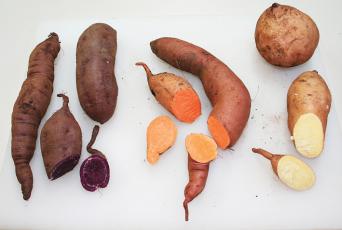
Slice It, Dice It, Serve It: The Scoop on Sweet Potatoes
They’re members of the morning glory family of plants
Botanically, sweet potatoes and true yams are distinct families of plants.
The use of “yam” to describe sweet potatoes arose in North America, possibly to differentiate between their many different cultivars. They include:
- Beauregard and Jewel: Among the most available cultivars found in the States. Both have orange skin and orange flesh. Beauregards tend to be a bit sweeter than Jewel varieties. The flesh is wet when cooked. Great for holiday classics, or baked and mashed.
- Garnet: Another orange-fleshed tuber, but distinguished by reddish-hued skin. Firm texture but still moist. Great for baking projects, but also good for roasting.
- Hannah: Oblong and tan-skinned with white flesh. The inside of the potato darkens to a yellow color as it bakes. Mildly sweet, starchier and drier than its orange-fleshed companions. Work great cubed and roasted with other vegetables. Makes excellent fries.
- Japanese sweets: Deep purple skin paired with a white flesh that darkens when cooked. Even drier and starchier than Hannahs. Also has the same sweet flavor, although it’s a bit milder and has more complex, nutty qualities.
At the end of the day, nothing beats a roasted sweet potato with a bit of butter. Remember that there are a lot of natural sugars that will bubble out, so line your sheet or baking dish with foil.
A few ideas: Add sweetness to a stew or chili with diced chunks, braise in a curry, or switch up the russet you’d use for your gnocchi for a sweet potato.
Fair warning: Substituting one type of sweet potato for another in a baking project is not an easy 1:1 swap. Each type varies in density, starch and moisture content.
One more thing: When available, sweet potato greens are a delightful change from the same old leafy varieties. Try them lightly sauteed or braised in a bit of coconut milk.

